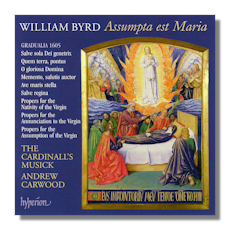
The Internet's Premier Classical Music Source
Related Links
- Byrd Reviews
- Latest Reviews
- More Reviews
-
By Composer
-
Collections
DVD & Blu-ray
Books
Concert Reviews
Articles/Interviews
Software
Audio
Search Amazon
Recommended Links
Site News
 CD Review
CD Review
William Byrd

Byrd Edition Volume 12
- Benedicta et venerabilis
- Felix es, sacra Virgo
- Beata es, Virgo Maria
- Beata viscera
- Quem terra, pontus, aethera
- Salve regina à 4
- O gloriosa Domina
- Vultum tuum
- Diffusa est gratia
- Ave Maria
- Ecce virgo concipiet
- Ecce virgo concipiet - Alleluia
- Memento, salutis auctor
- Salve sola Dei genetrix
- Ave maris stella
- Gaudeamus omnes in Domino
- Propter veritatem et mansuetudinem
- Assumpta est Maria
- Optimam partem elegit
The Cardinall's Musick/Andrew Carwood
Hyperion CDA67675
Most of the music contained in the two Gradualia volumes published by William Byrd in 1605 and 1607 (and republished together in 1610) was probably written in the 1590s and later. This was the period of the composer's life when we was attached to the Roman Catholic community of Sir John Petre at Ingatestone Hall near Stondon Massey in Essex. Celebration of Catholic rites was forbidden by the Protestant state then of Elizabeth I's. Yet much of what we hear on this, the twelfth and latest in their series of Byrd's works by The Cardinall's Musick under Andrew Carwood, was clearly written for such (surreptitious) celebration. On the surface – to Protestants – some of the pieces could be represented as wholesome spiritual entertainment. To Catholics, they were unambiguously indicative of known, recognizable and specific aspects of their faith. Byrd also seems to have enjoyed, if not royal favor, at least royal tolerance from Elizabeth for a variety of reasons… not least that he kept out of trouble; and was obviously so great a composer.
The annotation that Byrd supplied for the works makes no effort to hide an explicitly Catholic context for their use and performance. What is on this CD is best appreciated as music for Marian Feasts in the Catholic church year. It includes Propers for the Nativity [tr.s 1-8], the Annunciation [tr.s 9-15] and the Assumption [tr.s 16-19]. The first aspect of the music that's likely to strike you is its relatively positive tenor full of uplift and vitality. Energy, word painting, a madrigalian springiness pervade almost all the music. It's tempting to think that Byrd was invigorated by his association with like-minded believers and the opportunities to hear his music as he intended. Indeed, it's music with great confidence – as is perhaps reflected in the fact that he writes expansively for three distinct and separate moments in the Marian year.
The Gradualia, then, contain Introits, Graduals, Tracts, Alleluias, Offertories and Communions proper to the mass; that is, those which change according to the occasion. The way The Cardinall's Musick approaches these precisely and tautly written works would give next to no hint that Byrd had written them under what many would describe as conditions of duress. Stopping short of outright joyousness, the singers convey great conviction and in such pieces as the Introit and Gaudeamus omnes in Domino, [tr.16]. Their pace is brisk and the phrasing upbeat. But with a humility that suits beautifully the concentration with which they must first have been sung.
Other felicitous, and wholly deliberate, instances where Byrd matched text to music include the outburst of happiness at the words in the Introit, Vultum tuum, [tr.9]. Similarly remarkable for the way in which they exude faith and delight are the settings of the Gradual and Alleluia for the Assumption, Propter veritatem et mansuetudinem [tr.17]. Once more Carwood directs singers who, while fully in control, are clearly persuaded by Byrd's intentions and convictions. It would be strange if the team that has already produced eleven such collections of Byrd's music, were not now completely attuned to his idiom and the workings of his mind. They are.
The CD also includes four Hymns form the Little Office sung in the order in which they would have been sung during the liturgical day: Quem terra, pontus, aethera, O gloriosa Domina, Memento, salutis auctor and Ave maris stella. The latter contrasts in complexity and emotional range with the other three; at nearly eight minutes, it's also the longest piece on this CD. These, too, are the music of a Byrd who has apparently either come to terms with the Reformation in England and/or who has seen ways in which the legitimacy of his faith sponsored its own outlets and opportunities for expression – in his Essex "retreat".
If you've been collecting the Byrd-Cardinall's Musick-Carwood series on Hyperion, there can be no question that you will want to add this excellent and idiomatic volume. If you are familiar with the "darker", more downcast Byrd of the Cantiones Sacrae, then this music may come as something of a revelation for its airiness and even extrovert confidence, which is beautifully conveyed by these singers. The acoustic (The Fitzalan Chapel at Arundel Castle) is fittingly expansive without being too roomy; and there is an informative essay by Carwood together with the texts in Latin and English. Strongly Recommended.
Copyright © 2009, Mark Sealey




















